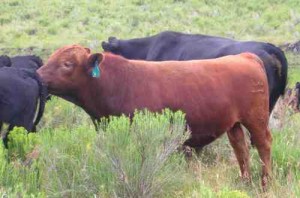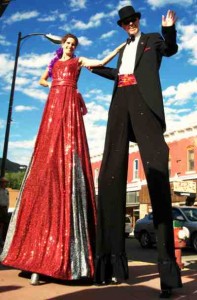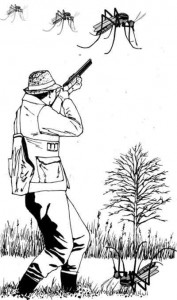Brief by Central Staff
Wildlife – August 2007 – Colorado Central Magazine
The security system at Central World Headquarters — that is, a mutt named Bodie — was bit by a rattlesnake on July 11 near Cleora. He’d been vaccinated with snakebite anti-venom, and he got to the vet quickly, so he was soon good as new.
From his 35 acres in Custer County, Hal Walter has also mentioned an abundance of serpents last summer and this one, including one on a flowerbed in the yard. And there’s been quite a bit of talk in and around Salida about more snakes than usual, especially on the Tenderfoot Hill side of the river (we’d say “north” or “east,” but Salida’s directions are peculiar on account of following railroad customs, rather than the compass).
This inspired some research into Colorado’s vipers. There are only two poisonous snakes native to the state. One of these rattlesnakes has a rather exotic name, massasauga. Sistrurus catenatus is widespread in the United States, but in Colorado lives only on the high plains east of Colorado Springs and Pueblo.
The other Colorado viper is the common “Western Rattlesnake.” As of last year, it had two sub-species, the “Prairie Rattler” and the “Midget Faded.” However, the latter appears to be in the process of becoming a separate species, as a result of DNA research.
As you might have guessed, the Midget Faded (Crotalus viridis concolor) is relatively small (20 inches at most), and in Colorado it lives primarily on the Western Slope in Montrose, Delta, and Mesa counties. However, it has been seen in many parts of the state.
The Prairie Rattler variant of the Western Rattlesnake (Crotalus viridis) is larger (30-48 inches) and more common.
Colorado folklore often holds that rattlers don’t live above 7,000 or 8,000 feet, but their range extends up to 9,500 feet, according to the Colorado Division of Wildlife, which maintains a Natural Diversity Information Service database. For Chaffee County, for instance, both Midget Faded and Western rattlesnakes are listed in the NDIS as “Known to Occur” but “Rare.” (There’s also “Sparsely Common,” applied to places like Weld County.)
For Custer, they’re “Known to Occur” and “Uncommon.” That also holds for Saguache County, where you pass Rattlesnake Hill while entering Saguache from Salida. Custer County also has a Rattlesnake Hill, as well as a Rattlesnake Gulch. Rattlesnake Mountain rises to 8,491 feet in Frémont County, and there’s a Rattlesnake Canyon in Huerfano County.
There are counties with no recorded rattlers: Jackson (Walden), Grand (Hot Sulphur Springs), Summit (Breckenridge), Lake (Leadville), Park (Fairplay), Pitkin (Aspen), Gunnison (Gunnison), Mineral (Creede), Hinsdale (Lake City), Ouray (Ouray), and San Juan (Silverton).
[InContentAdTwo]
For many of these, the reason is obvious — it’s hard to find a piece of real estate in Lake or San Juan County that’s under 9,500 feet. But considerable portions of Gunnison and Grand counties are low enough, so why no vipers?
For one thing, they have hard winters, perhaps too cold for successful hibernation. For another, there aren’t many ways for snakes to slither into those counties without getting too high. Gunnison County, for instance, is bounded by the Sawatch Range on the east, the West Elks on the north, the San Juans to the south, and Blue Mesa to the west. Invading rattlers would have had to swim upstream through the Black Canyon, an unlikely trek. In Grand County, they would have faced a similar swim up Gore Canyon.
Praire Rattlesnakes are a game animal in Colorado, with a hunting season that runs from June 15 to August 15 statewide.
Does killing them make us safer? First note that rattlers eat a lot of small rodents. Then observe that nationwide, about eight people a year die from rattlesnake bites. And about 15 die from Hantavirus, which is carried by small rodents; at press time, hantavirus had killed four Coloradans in 2007, with recent victims in Park and Custer counties
So it would appear that snakes are safer.



